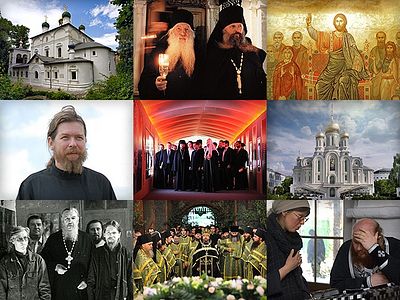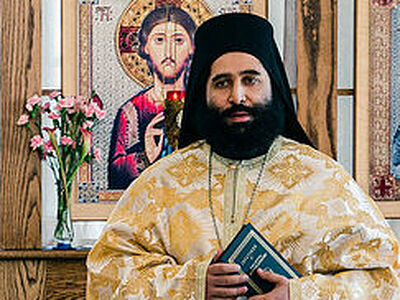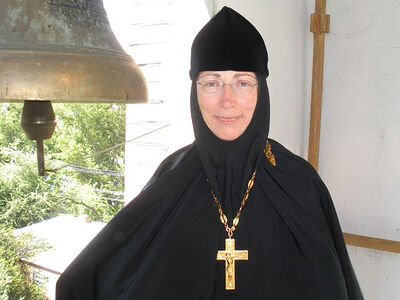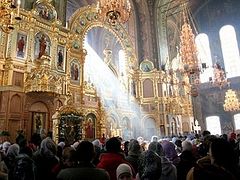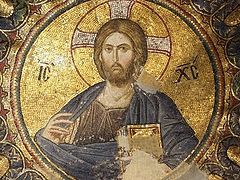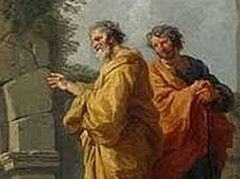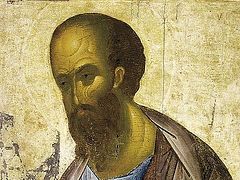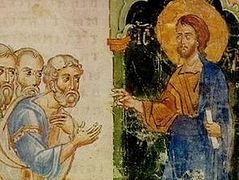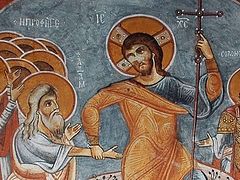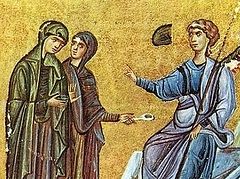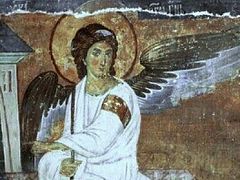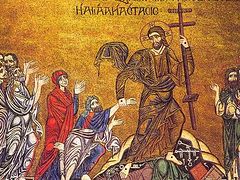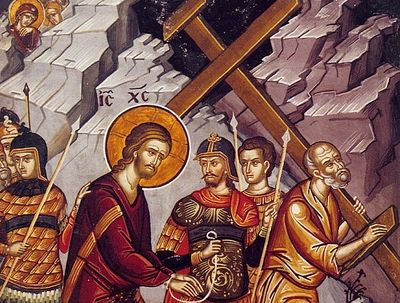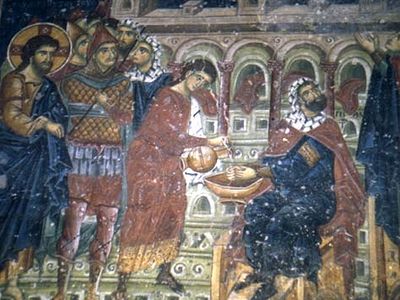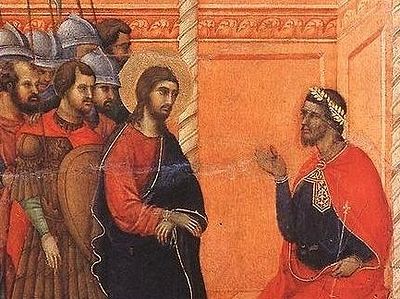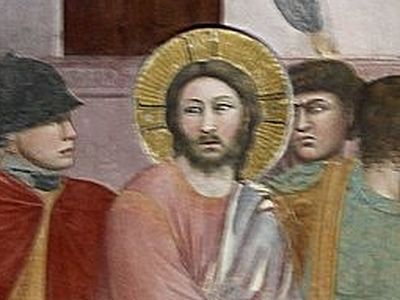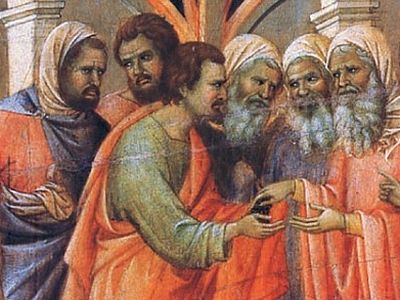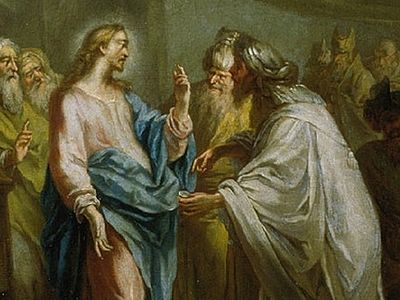See Christ is Risen! Part 5b. The Apostle Paul
In this lesson, Dr. Jeannie talks more about Tradition, and explains the discrepancies in the scriptural accounts about the early witnesses to Christ’s resurrection.
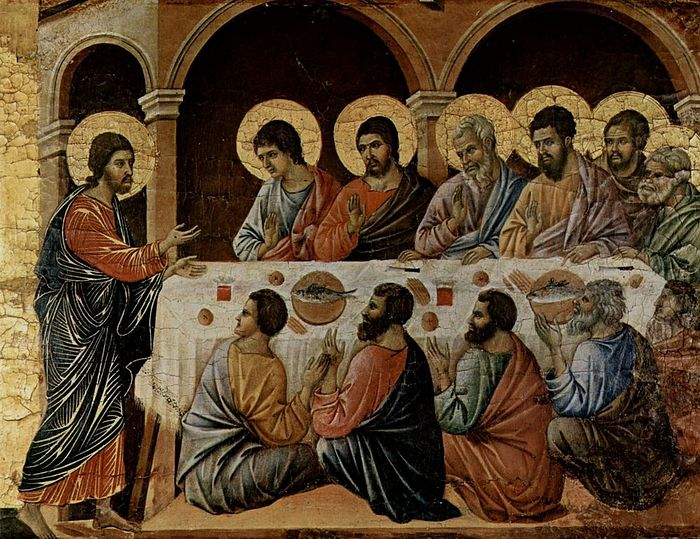 Duccio di Buoninsegna, Christ's Appearance to the Apostles, ca. 1308-1311
Duccio di Buoninsegna, Christ's Appearance to the Apostles, ca. 1308-1311 Christos Anesti! Christ is Risen!
Christ is Risen from the dead, trampling down death by death and upon those in the tombs bestowing life.
Are you saved?
Well let’s continue our discussion of 1 Corinthians 15, which I told you is the oldest written account of the Resurrection appearances of Christ. We will touch on a few areas of discussion that I did not have time to address last time, including some of the points made by St. John Chrysostom. Let’s remind ourselves of what St. Paul said. He began this chapter right away by reminding the Corinthians of what he had preached to them when he first met them. “Moreover brethren, I declare to you the Gospel which I preached to you, which also you received in which you stand, by which you are also saved, if you hold fast that word which I preached to you, unless you believed in vain”. Now notice that he says there in verse 2, “which you are saved if you hold fast to what I taught you.” What does he mean then by “saved”? Because here he says clearly that they are saved. We would never deny that they are saved, or that we are saved. Definitely we are saved. It’s not incorrect to say that, because Christ died once and for all. He rose from the dead and we are saved, we’re baptized and we are saved. But we are also being saved, and we also will be saved. Now here Paul says that they are saved if they continue the apostolic faith. Isn’t that interesting? Because when you say someone is saved, and he says they are saved, that’s an unconditional statement: “You are saved.” But then he adds immediately a condition: “If you hold fast to that word which I preached to you.” What is the condition for their continued salvation? That they maintain the apostolic oral tradition. Isn’t that interesting? That’s a pretty big “if.” That’s a condition. So here there is no hint of the popular Protestant doctrine, “Once saved, always saved”; by the way those words are not found anywhere in the Bible—that is a tradition created by men. That’s not apostolic and it’s certainly not biblical, and here we have Paul telling us that their salvation depends on their adherence to the apostolic tradition. This is referring to an unwritten tradition, because this is now the first time it is being written down, and it is preserved here for us in 1 Corinthians 15. So we can say categorically and unconditionally that we are saved by the death of Christ because Christ died for all people for all times. It was complete: Christ saved. There is nothing more to be done by Christ, but there is plenty more to be done by us to accept this gift of salvation and to continue to grow in our relationship with Christ, our life in Christ which was created when we were baptized, when we became a member of the Body of Christ—the Church.
So when he says, “in which you are saved if you hold fast,” it means they are saved, but only if they continue to maintain the apostolic faith; otherwise they have believed in vain, right? Now remember, I told you that the word “delivered” here, when Paul says, “I delivered to you,” in the next sentence, “I delivered to you” is the verbal form of the noun “tradition”; and this means that they received something that they were to preserve, that they were to keep. Paul said to them in verse 3 “for I delivered to you, first of all,” or, “as of first importance,” “that which I also received.” And I told you that Paul was catechized. He’s passing on to them the Apostolic Tradition. So if you hand something over to someone, that means they received it and they were to preserve it, to keep it. That was their charge, as like it is our charge today to preserve Apostolic Tradition.
St. John Chrysostom makes the same point, even a better point, because he notes that when Paul says to the Corinthians and reminds them that they received this tradition, it means that they believed it, and they became witnesses themselves. So here are Chrysostom’s words from Homily 38 on 1 Corinthians: “See how he calls them witnesses of the things spoken? And he says, not which you “heard,” but which you “received,” demanding it of them as a kind of deposit, showing that not in word only, but also by deeds and signs and wonders they received it, and that they should hold it safe.” So here Chrysostom is saying that the Apostolic testimony, being eyewitnesses to the Resurrection, was confirmed by the miracles that the Corinthians witnessed, which Paul and other Apostles performed—because they performed a great many miracles.
We also said last week that Paul reminded the Corinthians of what they had been taught, what they had accepted as a true apostolic tradition, and that the form in which this is stated by Paul reads like an early Creed, because he lists it. He says this is what I delivered to you, this is what I handed over to you, this is what I “traditioned” to you: “That Christ died for our sins according to the Scriptures, He was buried, that he rose on the third day according to the Scriptures, that he was seen by Cephas and by the twelve, by 500 all at once, then by James and by all the apostles.” And the way that he lists it sounds like an early Creed.
First appearance—to Peter?
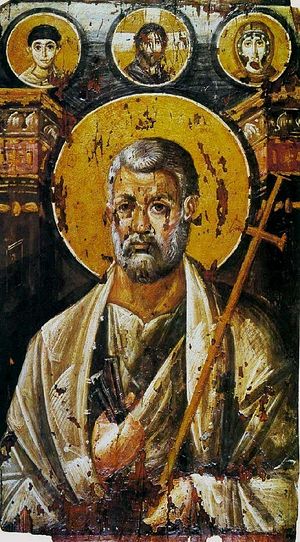 St Peter encaustic on panel, c. 6th century (Saint Catherine's Monastery)
St Peter encaustic on panel, c. 6th century (Saint Catherine's Monastery) He also said that He allowed him to see Him risen from the dead and because of this also give him first to be entrusted with his sheep. Now notice that Chrysostom says that Peter was first entrusted with his sheep. This is at the very last chapter of St. John’s Gospel. But he says, He first entrusted His sheep, not that He exclusively entrusted His sheep, because the gifts that were given, and the authority that was given to Peter—including for example to bind and loose sins—was given first to Peter because of his great confession of Christ when he said, “You’re the Messiah, the Son of God.” He was the first person to say that, and so Christ blessed him; and he was, because of this, one the leading Apostles or the leading Apostle. Christ also first entrusted to Peter the authority to bind and loose sins, but that was later given to all of The Twelve. Here also, Chrysostom is saying that Peter was entrusted with the care of the sheep, which is in the last chapter of the Gospel of John, and that this was also was given to all of the twelve.
Now, what else does St. Paul say? In verse six, that the Lord was seen by “over 500 brethren at once,” most of whom are still alive at the time that Paul was writing this, but some have “fallen asleep.” We also mentioned last time that this expression is the traditional Christian way of referring to death, that one has “fallen asleep”; Christ used this expression. It was also used by St. Paul in more than one place in his epistles. But I like what Chrysostom has to say about this little expression. He notes that Paul does not say that some of those 500 have died, but that they are “fallen asleep,” and by this expression also, again, Paul confirms the Resurrection. I think that’s a very nice touch, because he’s saying that to say that “one has fallen asleep” means that they will wake up. They will rise again; and even this little detail, and the manner in which Paul expresses, confirms the Resurrection. Then in verse 7 Paul tells us that the Lord was seen by James and by “all of the Apostles.”
So this is the earliest written account of the resurrection appearances of Christ. But there is something quite important that is missing from Paul’s recitation of this oral tradition, isn’t there? And Chrysostom notes this also. He’s very aware of the fact that there seems to be some disagreement here between Paul’s account and the Gospels. And what is it? Who were the first people to see the risen Christ? According to the Gospels, it was the women, the myrrh-bearers. Now, Paul only mentions Peter at first. So why does Paul omit them, the women, from his creed? You should be able to figure this out by now, because I have mentioned it quite a few times: it was due to the status of women in Jewish society. Because Paul says that these people he mentions first: Peter, and then the twelve, and then the 500, and then James and all the Apostles, etc.—these are all men. Or predominantly men. (I would think there would be some women in there.)
Paul says that these are witnesses to the Resurrection, and a woman could not be a witness under Jewish law. Now you might think, “Well, Paul is recording history here. He’s telling us that Christ was first seen by this person and this person.” And after all Paul is a saint, right? And Paul was not a misogynist—that’s someone who hates women. Paul instead had a lot of women who were very close coworkers of his. Among them were Priscilla, who was always mentioned first in the book of Acts before her husband Aquila, and Chrysostom says that she was always mentioned first because she was the more important of the two. She was a leader and a teacher in the early Church. There was Phoebe, the deaconess of Cenchrae. There was Junia, who was always listed in Romans 16 and specifically mentioned as an Apostle, and Mary Magdalene who was definitely an apostle and one of the leading apostles. So, all of these women were very important in the early Church. And Paul was not someone who thought lowly of women. So why doesn’t he mentioned them? Because you cannot remove Paul from his time. You can’t expect Paul to think like a twenty-first century Westerner, an American, an Australian, a German, a South African, wherever you live—you can’t expect Paul to think like you today. Paul was a first century Jewish man. So, on the one hand, he can say these beautiful words inspired by the Holy Spirit, that “in Christ there is no male or female,” etc. But, on the other hand, he still conforms to many of the norms of his culture, and we see this not only in the fact that he omits the witness of the women—because it didn’t count—but also in other ways.
For example, he writes to Philemon about Philemon’s runaway slave Onisimus and never chastises Philemon for having a slave. Many people are very disappointed with this. Somehow they expect Paul to rise above his culture and make a statement on the evils of slavery. But that’s not the way people thought in those days. It’s quite unfair to criticize Paul for being a man of his time. We do the same in a thousand ways. We accept the norms of our culture and we don’t see how it is an accepted norm, but it may not be true. Now, not so long ago in America 150 or 160 years ago, at least half of the people in America believed that slavery was okay. One hundred years ago it was routine for children to be employed in America in factories, to have child labor. Not so long ago people routinely beat their children. All those things were accepted in the culture. Today, we also have certain things we accept in our culture about which a hundred years from now people will say, “How could they think that!? How could they do that!?” So it’s quite unfair for us to judge Paul against the standards of our times, because he, in many ways, did conform to the standards of his times. So Paul does not list the women—the testimony of women was not acceptable under Jewish law, so why should he bother? And do you know where else we see this? It’s quite interesting. When the Gospels give us the genealogy of Christ, whose genealogy do they list? Do you realize that Matthew’s Gospel begins with the genealogy of Christ, but whose genealogy is it? It’s the genealogy of Joseph! It ends with Joseph. It says that he was “the father of Joseph, the husband of Mary from whom was born the Christ,” and then it goes on to tell you that Joseph is not the father of Christ! So why give the genealogy of Joseph? To us that doesn’t make any sense, but to Matthew and any first century Jewish male it made perfect sense, because you would never give the genealogy of a woman! That was absolutely unthinkable! It was so unthinkable as to be ridiculous, for reasons we can go into.
Perhaps some other time we’ll discuss the genealogy. But the fact is, they had a very different way of thinking about things. And if we wish to understand the Bible, we have to understand it in its historical context. So it is quite impossible that Paul did not know about the women witnesses, or the empty tomb, or any of these, even though he doesn’t mention it. And there are other appearances Paul doesn’t mention, which he must have known about, such as the appearance on the road to Emmaus, the appearance by the sea of Tiberius, etc. Thus, neither do the Gospels list everything that happened, nor does Paul mention everything that happened—because neither Paul’s epistles nor the Gospels were intended to be an absolutely comprehensive account of everything that happened. Nobody wrote like that in those days.
So we have to accept them in the way in which they were intended and not think or allow people to tell us that, “Oh there’s a discrepancy there in the accounts.” Now Chrysostom mentions the fact, he notes the same thing—that Christ actually appeared to the women first but Paul doesn’t mention them. So what does he say? “Thus since he had mentioned the proof from the Scriptures”… By that he means the statements of Paul that Christ rose according to the Scriptures; “he adds also that by the events producing as witnesses of the Resurrection, after the Prophets, the apostles and other faithful men. Yet surely the Gospel says the contrary, that He was seen of Mary first. But among men, He was seen by him first who did most of all long to see him.” So, Chrysostom simply takes this exactly as I said: that here Paul is listing only the men. He perhaps did not know that women weren’t allowed to testify in court under Jewish law, but he recognizes that this is a listing of men, and the first man who was permitted to see the risen Christ was the one who longed to see him the most: St. Peter. The following is Chrysostom’s observation in connection with this, when he talks about the different appearances to different people at different times: “He appears also to each at intervals and at one time to fewer at another to more, hereby making them witnesses and teachers of each other.” And this goes along with what he had said previously, in some of His comments I cited earlier about why Christ appears at different times and different places to different people: that He gives them what they need. Peter was mourning Christ so much so that He appeared to him first among the men. Also about Mary, that the women see the angels but the men do not. So each of the appearances is tailored to what the person needs. Sometimes they recognize Him, sometimes they do not.
Now here Chrysostom says that He appears at different times and different places to different people because He wants them to witness to each other and to teach each other. Isn’t that interesting? After all, we’re talking here about the apostles! So they are to be witnesses and teachers of each other. I think that’s a beautiful image. It’s something that we could also learn from. If the apostles themselves were to be witnesses of the Resurrection, to share with each other what they had experienced and to also teach each other, shouldn’t we also continue to do that? We should be teaching each other in the Church and sharing with each other what we have learned. Isn’t that a nice concept?
To be continued.
Next Christ is Risen! Part 6b. The Resurrection of the Body
Presbytera and Dr. Jeannie Constantinou’s podcasts can be found here.


